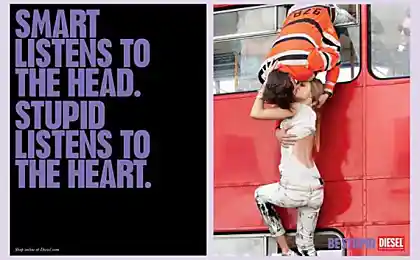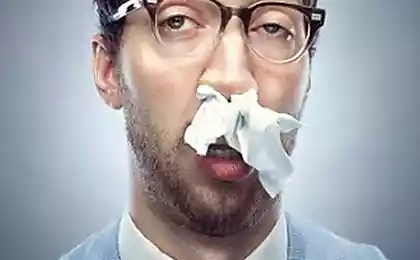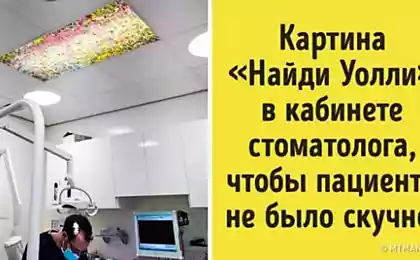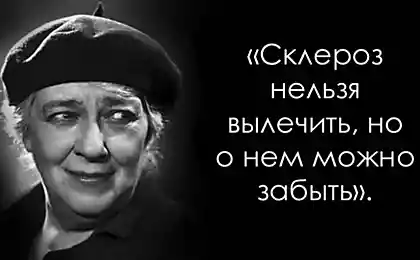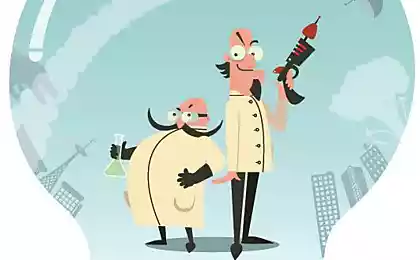1346
10 stupid mistakes brilliant scientists
Genius - paradoxes drug
Any more or less held one knows that promote success in large part consists of a failure. Even excellent minds err, And not every thinker can admit they were wrong, especially if behind him hangs a solid load of scientific achievements and merits. Nevertheless, the history of science - is a story of trial and error, which made all without exception great scholars on the way to world recognition, and sometimes after it took place.
1. The first flight Nikola Tesly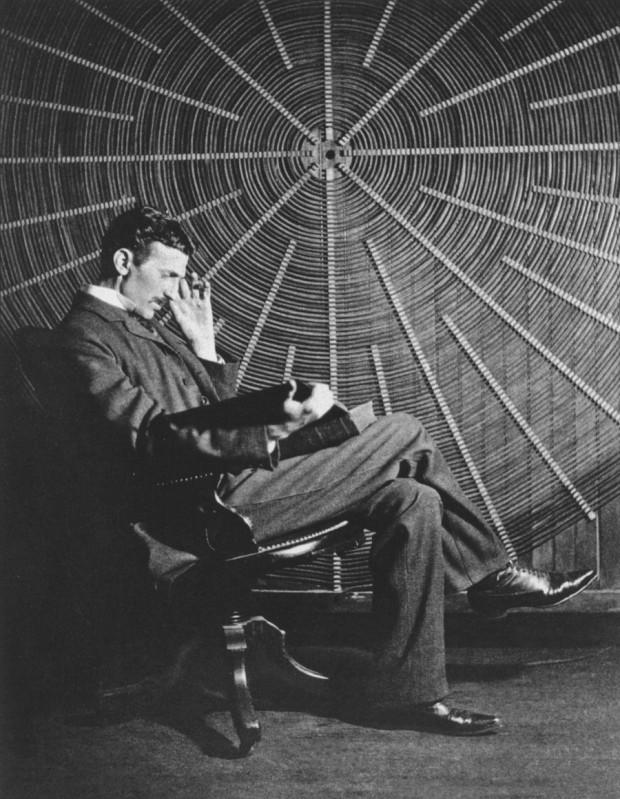
Nikola Tesla, without a doubt, one of the greatest scientists in the history of mankind. His experiments have identified the development of science in the decades to come, thanks in part to Tesla, we have the opportunity to enjoy the fruits of scientific and technological progress, although contemporaries considered great scientist eccentric, not to say - a madman. In recent years, the life of Nikola Tesla engaged in the development of smart devices such as an earthquake or a generator unit, creating the so-called death rays that only fueled the rumors of his madness. Genius has put a lot of experiments with one of the most fun experiences he went through in his childhood, though he almost became a torch for the future of the latest scientific thinking.
Once the young Nicolas noticed that after a few minutes of hyperventilation (ie, heavy breathing, in which the light comes in too much oxygen), he experiences an extraordinary lightness - the boy thought he could literally float in the air. The experimenter decided to see if he could help with hyperventilation overcome gravity. Taking umbrella Tesla climbed onto the roof of the barn, and began to breathe deeply until he felt dizzy and jumped down. Needless to say that his flight was short-lived - on impact Nikola lost consciousness, and after a while the boy found a frightened mother and the next few weeks, the future genius spent virtually under house arrest.
2. Architectural ambitions of Thomas Edisona
In 1877, the year Thomas Edison, Tesla's contemporary and part-time - his main rival in scientific researches, found near Long Island black magnetic sand deposits containing iron ore. Inspired by the idea of the development of these deposits, the eminent physicist few years developed various methods of extracting iron from the local sand. Edison patented a number of technologies, but none of them have not brought the desired result, American newspapers, as it is now expressed, actively "Troll" scientist, calling his efforts "nonsense».
To prove to everyone the prospect of their research, the physicist's own Money organized a company to process iron ore, but his idea failed miserably: not only that the methods of extraction have been ineffective - during the collapse of one of the industrial buildings were lost a few workers, followed by the development of deposits had stop.
Edison soon became interested in the idea of a wide application in the construction of the new (at the time) material called concrete. Scientists believe that the concrete can be cast not only building materials, but also skeletons of buildings, furniture, and even the body of musical instruments such as piano. The physicist claimed that its technology will at times reduce the cost of housing, he even found a businessman willing to invest a lot of money into the project. As well as the development of iron ore, its "Concrete Dreams" have failed - every house, built on a revolutionary technology, demanded the creation of dozens of forms in which it was necessary to fill in the solution, which significantly increases the cost of such construction. According to the technology of Edison was built 11 houses, but their customers, they have not been found.
3. Eternal Universe Einstein
Albert Einstein's contribution to the development of science can not be overestimated - in his writings scientist formulated the basic provisions of a physical model of the world, which is still used in modern physics as one of the main. However, with all the merits and outstanding achievements, the great physicist, like any other human being, sometimes wrong in their assumptions. One of his major errors can be considered the postulate that the universe will exist forever.

Albert Einstein believed that the universe is infinite way of life, although more in his life began to gain popularity of the Big Bang theory, according to which the universe ever cease to exist. During a meeting with one of the authors of the theory, the Belgian mathematician and priest Georges Lemaître Albert even had the courage to say: "Your calculations are correct, but your understanding of physics disgusting».
In 1930, Einstein was working on his own model of the universe - in one of the previously unknown manuscripts of the great scientist, which was discovered recently, contains scientific calculations, similar to the steady state theory, developed in the 1940s as an alternative to the Big Bang theory.
4. The steady state theory of Fred Hoyla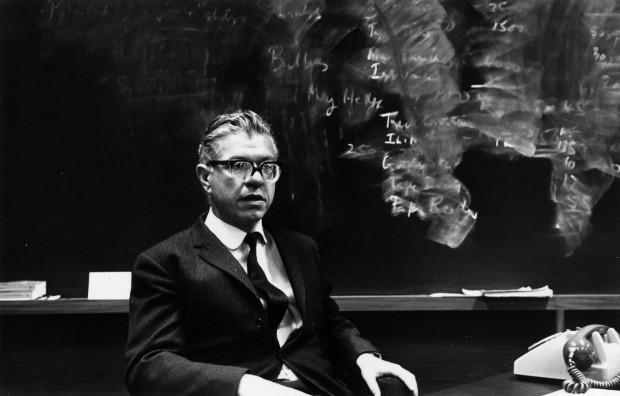
Einstein was not the only opponent of the Big Bang theory - the British astronomer Sir Fred Hoyle also refer to this concept with a grain of salt. Hoyle is known as the creator of steady state theory, largely coincides with Einstein's misconceptions about the structure of the cosmos.
Fred, was undoubtedly one of the most outstanding scientists of his time - his studies shed light on the formation of stars and nuclear processes occurring in them, but fascinated by the idea of a stationary universe, the British thoroughly damped his reputation in the scientific community.
Hoyle arranged public lectures, trying to convey their views to the public, but he appealed largely to the feelings of the audience, without giving almost no evidence in favor of the steady state theory. That Hoyle coined the name "Big Bang theory" - According to scientists, this phrase was to discredit the ideas of his scientific opponents, however, it turned out exactly the opposite - a theory with such a beautiful name has found more and more supporters, while the ideas of Hoyle and remained ideas are not scientifically proven. Eventually, physicists proved the fallacy of the theory of Hoyle, so now it is perhaps that the historical value.
5. Electric turkey Benjamin Franklina
Probably many of you have seen denominations of $ 100, and some even remember what they portrayed Benjamin Franklin - the famous politician, writer, scientist and inventor. This extraordinary man was actively interested in the achievements of scientific and technological progress and conducted numerous experiments with electricity. Among them were the experiments on the effects of electric current on animals - probably if Franklin is practiced today, his portrait appeared unlikely to be on one of the world's most popular banknotes.
During his experiments, Franklin discovered that electricity can be used in cooking, and then made a series of parties with exemplary "punishment" turkey electric shock. One of these scientific and educational meetings almost killed selfless experimenter - trying to kill another bird, Franklin received a powerful electric shock and fainted before his death, scaring guests. Fortunately, the blow was not fatal and learned soon woke up, the fate of the turkey history is silent.
6. Young Universe Edwin Hubble
Edwin Hubble - one of the founders of modern astronomy, his humanity was limited to timid assumptions and vague concepts about the structure of space, but with the advent of Hubble Astronomy in all radically changed. Scientists have proven that the world is not limited to the Milky Way, our galaxy that is a tiny part of an unimaginably vast universe, which is also constantly expanding.
Merit Hubble before modern science are invaluable, but at least one great scientist was wrong - in 1929, trying to calculate the age of the universe, astronomer came to the conclusion that it appeared about 2 billion years ago. However, only a few years, physicists have calculated the approximate age of the earth - from 3 to 5 billion years, so that Hubble had to admit the error of their calculations.
7. Triple Helix Linus Polinga
The scientific achievements of the famous American scientist Linus Pauling, you can talk for hours, but to understand the value of work chemist enough and the fact that Pauling won two Nobel Prizes (in Chemistry and Peace Prize).
In the 1950s, Pauling was developing a model of the structure of DNA, similar research conducted at this time, and two other prominent scientists - Francis Crick and James Watson. As a result, they received a "Nobel Prize" for his model of the DNA double helix, which is now recognized as true without exception scientific community.

After reviewing the results of their work, Pauling realized that was wrong. In his own concept he spoke of the triple helix, and this was not the case when you could say "single chain of nucleotides more one less - what's the difference?».
8. Charles Darwin and nasledstvennost
Works of Charles Darwin made a real revolution in science, his theory of the origin of species is not immediately received wide acclaim, but now it is used as the basic model of the evolution of life on our planet, although the entire prospect conclusions Darwin, his ideas were not without drawbacks.
In Darwin's time people have had a very vague idea of the inheritance of genetic traits, say, the majority of physicians in XIX-th century believed that genes are passed from generation to generation through the blood. Darwin believed that each offspring randomly mixed genetic characteristics of both parents at the same time according to his theory of evolution must not be transmitted random signs and dominant, that is pronounced, and help improve the survival rate of the form - a contradiction there. If the assumption of Darwin was right on inheritance, evolution has come to a standstill before the appearance of man, but even knowing about the diversity of life on Earth, which is possible only with the election of transferring genetic traits scientist stubbornly refused to admit his mistake.
9. The theory of tides Galileya
Galileo was never afraid of criticism, even when he knew that his ideas will serve as a pretext for attacks and harassment by members of orthodox science and the church. The dedication of the researchers in the pursuit of their own scientific views has long been a byword at the life he was forced to give up some of the statements under threat of death, but later the Catholic Church has recognized the correctness of the scientist, however, there is a three and a half centuries after his death.
Without belittling the merits of Galileo to the world of science, it is worth noting that one of the assumptions of the great thinker was not scientifically proven. Galileo tried to explain the ebb and flow of the seas of the earth rotation of Earth around the sun, but to produce evidence of this idea, a scientist and could not - simply because they did not exist in reality. It is curious that Galileo knew about the hypothesis of the German scientist Johannes Kepler, who explained the tides pull of the moon and sun, but felt his concept of "frivolous».
10. Isaac Typo Nyutona
"Mathematical Principles of Natural Philosophy" by Isaac Newton is considered one of the greatest scientific works, thousands of references to the outstanding work of genius British scientist, it only confirms. For three hundred years Newton's work is among the most cited monographs in the history of science, but the surprising fact that all this time, "Elements" contain simple math error, which, until recently, no one paid attention.
In one section of the "Principia" Newton resulting formula for calculating the mass of the known planets, which, among other things, used the angle formed by two definite lines. Some calculations Newton working with an angle value of 11 arc seconds, and in another part of the same calculation using the angle of 10, 5 seconds.
I must say, the error is of a formal nature and does not affect the value of scientific calculations of Newton, but it remains unclear how the thousands of people who for hundreds of years he studied the work of the British (among them were truly great minds), have managed to overlook this "typo"? An error was recently discovered 23-year-old student named Robert Garisto, which is likely to show off their grandchildren that surpassed Newton himself if not in scientific achievements, then at least - in care.
via factroom.ru

Any more or less held one knows that promote success in large part consists of a failure. Even excellent minds err, And not every thinker can admit they were wrong, especially if behind him hangs a solid load of scientific achievements and merits. Nevertheless, the history of science - is a story of trial and error, which made all without exception great scholars on the way to world recognition, and sometimes after it took place.
1. The first flight Nikola Tesly

Nikola Tesla, without a doubt, one of the greatest scientists in the history of mankind. His experiments have identified the development of science in the decades to come, thanks in part to Tesla, we have the opportunity to enjoy the fruits of scientific and technological progress, although contemporaries considered great scientist eccentric, not to say - a madman. In recent years, the life of Nikola Tesla engaged in the development of smart devices such as an earthquake or a generator unit, creating the so-called death rays that only fueled the rumors of his madness. Genius has put a lot of experiments with one of the most fun experiences he went through in his childhood, though he almost became a torch for the future of the latest scientific thinking.
Once the young Nicolas noticed that after a few minutes of hyperventilation (ie, heavy breathing, in which the light comes in too much oxygen), he experiences an extraordinary lightness - the boy thought he could literally float in the air. The experimenter decided to see if he could help with hyperventilation overcome gravity. Taking umbrella Tesla climbed onto the roof of the barn, and began to breathe deeply until he felt dizzy and jumped down. Needless to say that his flight was short-lived - on impact Nikola lost consciousness, and after a while the boy found a frightened mother and the next few weeks, the future genius spent virtually under house arrest.
2. Architectural ambitions of Thomas Edisona

In 1877, the year Thomas Edison, Tesla's contemporary and part-time - his main rival in scientific researches, found near Long Island black magnetic sand deposits containing iron ore. Inspired by the idea of the development of these deposits, the eminent physicist few years developed various methods of extracting iron from the local sand. Edison patented a number of technologies, but none of them have not brought the desired result, American newspapers, as it is now expressed, actively "Troll" scientist, calling his efforts "nonsense».
To prove to everyone the prospect of their research, the physicist's own Money organized a company to process iron ore, but his idea failed miserably: not only that the methods of extraction have been ineffective - during the collapse of one of the industrial buildings were lost a few workers, followed by the development of deposits had stop.
Edison soon became interested in the idea of a wide application in the construction of the new (at the time) material called concrete. Scientists believe that the concrete can be cast not only building materials, but also skeletons of buildings, furniture, and even the body of musical instruments such as piano. The physicist claimed that its technology will at times reduce the cost of housing, he even found a businessman willing to invest a lot of money into the project. As well as the development of iron ore, its "Concrete Dreams" have failed - every house, built on a revolutionary technology, demanded the creation of dozens of forms in which it was necessary to fill in the solution, which significantly increases the cost of such construction. According to the technology of Edison was built 11 houses, but their customers, they have not been found.
3. Eternal Universe Einstein
Albert Einstein's contribution to the development of science can not be overestimated - in his writings scientist formulated the basic provisions of a physical model of the world, which is still used in modern physics as one of the main. However, with all the merits and outstanding achievements, the great physicist, like any other human being, sometimes wrong in their assumptions. One of his major errors can be considered the postulate that the universe will exist forever.

Albert Einstein believed that the universe is infinite way of life, although more in his life began to gain popularity of the Big Bang theory, according to which the universe ever cease to exist. During a meeting with one of the authors of the theory, the Belgian mathematician and priest Georges Lemaître Albert even had the courage to say: "Your calculations are correct, but your understanding of physics disgusting».
In 1930, Einstein was working on his own model of the universe - in one of the previously unknown manuscripts of the great scientist, which was discovered recently, contains scientific calculations, similar to the steady state theory, developed in the 1940s as an alternative to the Big Bang theory.
4. The steady state theory of Fred Hoyla

Einstein was not the only opponent of the Big Bang theory - the British astronomer Sir Fred Hoyle also refer to this concept with a grain of salt. Hoyle is known as the creator of steady state theory, largely coincides with Einstein's misconceptions about the structure of the cosmos.
Fred, was undoubtedly one of the most outstanding scientists of his time - his studies shed light on the formation of stars and nuclear processes occurring in them, but fascinated by the idea of a stationary universe, the British thoroughly damped his reputation in the scientific community.
Hoyle arranged public lectures, trying to convey their views to the public, but he appealed largely to the feelings of the audience, without giving almost no evidence in favor of the steady state theory. That Hoyle coined the name "Big Bang theory" - According to scientists, this phrase was to discredit the ideas of his scientific opponents, however, it turned out exactly the opposite - a theory with such a beautiful name has found more and more supporters, while the ideas of Hoyle and remained ideas are not scientifically proven. Eventually, physicists proved the fallacy of the theory of Hoyle, so now it is perhaps that the historical value.
5. Electric turkey Benjamin Franklina

Probably many of you have seen denominations of $ 100, and some even remember what they portrayed Benjamin Franklin - the famous politician, writer, scientist and inventor. This extraordinary man was actively interested in the achievements of scientific and technological progress and conducted numerous experiments with electricity. Among them were the experiments on the effects of electric current on animals - probably if Franklin is practiced today, his portrait appeared unlikely to be on one of the world's most popular banknotes.
During his experiments, Franklin discovered that electricity can be used in cooking, and then made a series of parties with exemplary "punishment" turkey electric shock. One of these scientific and educational meetings almost killed selfless experimenter - trying to kill another bird, Franklin received a powerful electric shock and fainted before his death, scaring guests. Fortunately, the blow was not fatal and learned soon woke up, the fate of the turkey history is silent.
6. Young Universe Edwin Hubble
Edwin Hubble - one of the founders of modern astronomy, his humanity was limited to timid assumptions and vague concepts about the structure of space, but with the advent of Hubble Astronomy in all radically changed. Scientists have proven that the world is not limited to the Milky Way, our galaxy that is a tiny part of an unimaginably vast universe, which is also constantly expanding.
Merit Hubble before modern science are invaluable, but at least one great scientist was wrong - in 1929, trying to calculate the age of the universe, astronomer came to the conclusion that it appeared about 2 billion years ago. However, only a few years, physicists have calculated the approximate age of the earth - from 3 to 5 billion years, so that Hubble had to admit the error of their calculations.
7. Triple Helix Linus Polinga

The scientific achievements of the famous American scientist Linus Pauling, you can talk for hours, but to understand the value of work chemist enough and the fact that Pauling won two Nobel Prizes (in Chemistry and Peace Prize).
In the 1950s, Pauling was developing a model of the structure of DNA, similar research conducted at this time, and two other prominent scientists - Francis Crick and James Watson. As a result, they received a "Nobel Prize" for his model of the DNA double helix, which is now recognized as true without exception scientific community.

After reviewing the results of their work, Pauling realized that was wrong. In his own concept he spoke of the triple helix, and this was not the case when you could say "single chain of nucleotides more one less - what's the difference?».
8. Charles Darwin and nasledstvennost

Works of Charles Darwin made a real revolution in science, his theory of the origin of species is not immediately received wide acclaim, but now it is used as the basic model of the evolution of life on our planet, although the entire prospect conclusions Darwin, his ideas were not without drawbacks.
In Darwin's time people have had a very vague idea of the inheritance of genetic traits, say, the majority of physicians in XIX-th century believed that genes are passed from generation to generation through the blood. Darwin believed that each offspring randomly mixed genetic characteristics of both parents at the same time according to his theory of evolution must not be transmitted random signs and dominant, that is pronounced, and help improve the survival rate of the form - a contradiction there. If the assumption of Darwin was right on inheritance, evolution has come to a standstill before the appearance of man, but even knowing about the diversity of life on Earth, which is possible only with the election of transferring genetic traits scientist stubbornly refused to admit his mistake.
9. The theory of tides Galileya

Galileo was never afraid of criticism, even when he knew that his ideas will serve as a pretext for attacks and harassment by members of orthodox science and the church. The dedication of the researchers in the pursuit of their own scientific views has long been a byword at the life he was forced to give up some of the statements under threat of death, but later the Catholic Church has recognized the correctness of the scientist, however, there is a three and a half centuries after his death.
Without belittling the merits of Galileo to the world of science, it is worth noting that one of the assumptions of the great thinker was not scientifically proven. Galileo tried to explain the ebb and flow of the seas of the earth rotation of Earth around the sun, but to produce evidence of this idea, a scientist and could not - simply because they did not exist in reality. It is curious that Galileo knew about the hypothesis of the German scientist Johannes Kepler, who explained the tides pull of the moon and sun, but felt his concept of "frivolous».
10. Isaac Typo Nyutona

"Mathematical Principles of Natural Philosophy" by Isaac Newton is considered one of the greatest scientific works, thousands of references to the outstanding work of genius British scientist, it only confirms. For three hundred years Newton's work is among the most cited monographs in the history of science, but the surprising fact that all this time, "Elements" contain simple math error, which, until recently, no one paid attention.
In one section of the "Principia" Newton resulting formula for calculating the mass of the known planets, which, among other things, used the angle formed by two definite lines. Some calculations Newton working with an angle value of 11 arc seconds, and in another part of the same calculation using the angle of 10, 5 seconds.
I must say, the error is of a formal nature and does not affect the value of scientific calculations of Newton, but it remains unclear how the thousands of people who for hundreds of years he studied the work of the British (among them were truly great minds), have managed to overlook this "typo"? An error was recently discovered 23-year-old student named Robert Garisto, which is likely to show off their grandchildren that surpassed Newton himself if not in scientific achievements, then at least - in care.
via factroom.ru
Double Kasortso Tree: tree growing on top of another tree
At Ian McKellen, Sean Bean and other members of the Fellowship of the Ring has the same tattoo
